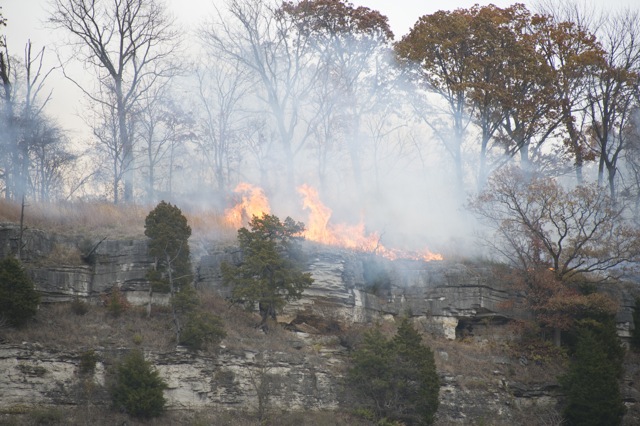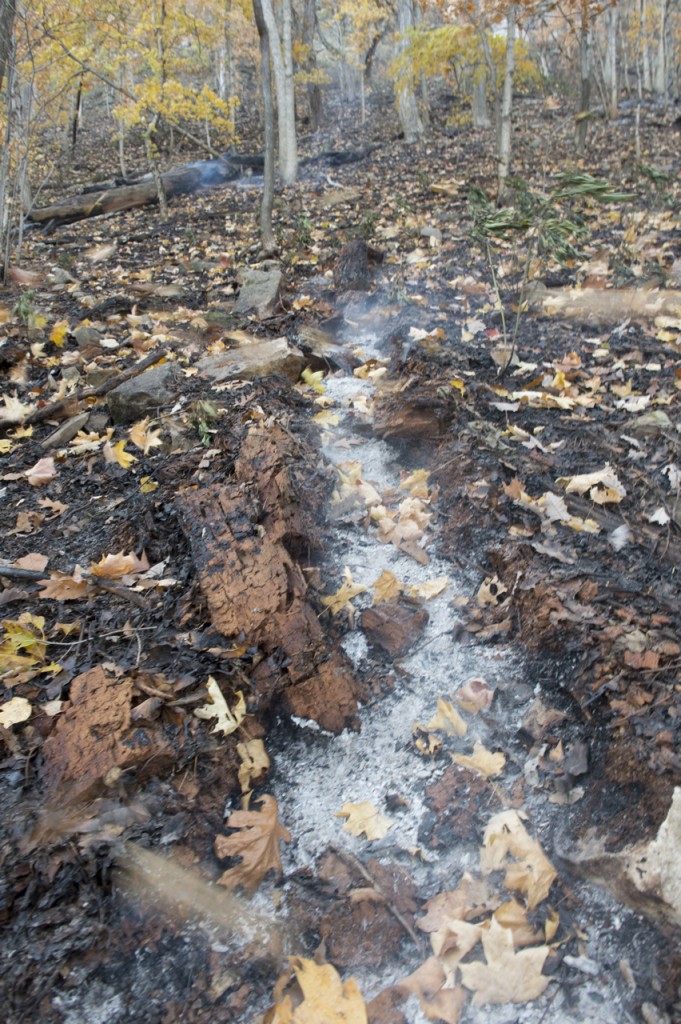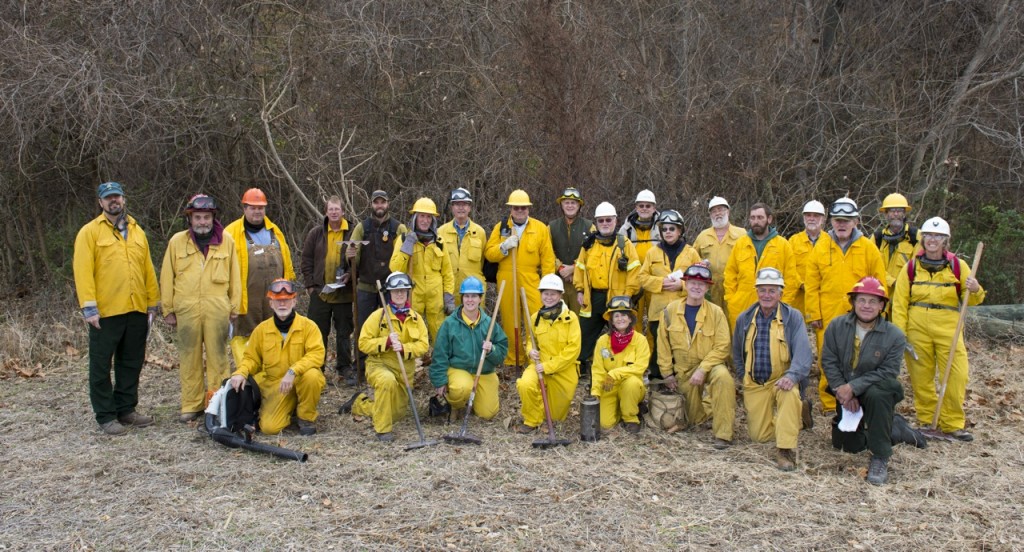Fire: It’s Elemental

Periodic prescribed burns, like this one along the Monroe County bluffs, benefit both prairies and woodlands. Photo courtesy Tom Rollins, ThomasRollinsphotography.com
Earth, air, fire, and water were proposed as essential elements by the earliest Greek philosophers. Centuries later, our view of life is a bit more complex and informed by scientific observation and experimentation. But earth, air, fire and water still are essential components to the health of our bluff lands. Earth, air and water seem more intuitive than fire, but fire, too, plays a role and contributes to the preservation of our natural areas and our natural heritage.
Most of our native plants are tolerant of fire; indeed, many native plants benefit from and even depend upon fire. Our woodland communities, with their natural oak-hickory dominance, benefit from the occasional fire that reduces competition from understory trees and shrubs and brings sunlight to the forest floor thus allowing acorns and hickory nuts to germinate and grow into stout saplings. Increased sunlight on a less crowded forest floor also allows wildflowers to flourish, carpeting woodlands with colorful tapestries of beauty for us to admire and providing needed food, in the form of nectar, pollen, leaves, stems, fruits, and tubers for a host of wildlife.
Grasslands – our hill prairies and glades – also benefit greatly from occasional fire. The detritus of years of growth is consumed by fire, again, enabling sunlight to reach down to the earth. The deep roots of our native fire tolerant grasses and flowers are not harmed by fire but are protected by the earth and are stimulated into stronger growth.

The aftermath of a prescribed burn is the release of nutrients in the form of ash that melts into the soil. Photo courtesy Tom Rollins, ThomasRollinsPhotography.com
The remains of fire join with the earth through the actions of air and water as the ash melts into and becomes part of the soil. Wildflowers and grasses in both woodlands and grasslands often have a tremendous bloom response in the growing season after a fire because of the tremendous addition of nutrients made possible by fire.
Some plant species do not tolerate fire and are set back as a result of a burn. These include many non-native invasive plant species, like bush and vine honeysuckle, and Tree-of-Heaven, as well as native species such as sugar maple and poison ivy. Burning helps control and reduce populations of these invasive species, lowering their competitive advantage over native plants. Wildlife flourishes in native plant ecosystems.
Fire benefits wildlife by helping restore and maintain these ecosystems. Fire will consume some of the insects and invertebrates that comprise the bulk of animal species in our prairie and forest communities. But, even these fire-sensitive species quickly re-colonize burned areas from nearby unburned areas and often will increase their populations due to the favorable response to fire by native plants.
Our native oak/hickory forests and our hill prairies and glades need periodic fire to prosper. Native Americans had routinely set fire to our woods and grasslands to keep them productive for hunting and agriculture. The early Euro-American settlers continued the practice, burning the woods two or three times each decade. Our great-grandfathers and grandfathers burned woodlots and pastures in the bluffs into the 1950s.
The cessation of periodic fire in our bluffs has had transformative and negative impacts over the last fifty years.
Our canopy-dominant oaks and hickories are now mostly mature or over-mature trees. Shorter-lived hackberries and persimmons, which share the canopy, mostly are entering extreme old-age decline and senescence. None of these native trees are regenerating very well anymore.
Instead, fire-intolerant native sugar maples and nonnative Tree-of-Heaven are taking over the mid-story of our woodlands. And, nonnative fire-intolerant bush honeysuckle shrubs are taking over the understory. Taken together, these invasives are shading out new oak-hickory regeneration. It simply is too shady for acorn and nut seedlings to sprout and grow.
In time, largely because of the lack of fire, our oak-hickory forest will be no more. Then, our acorn and nut-dependent deer, turkey, quail and a host of non-game critters will have insufficient food, shelter – habitat – to successfully reproduce. Our dappled-light loving, open-woods dependent wildflowers and mushrooms will go away. And, our open trails and scenic swales will be a thing of the past.
Recognizing these negative impacts to our forests, in recent decades, science-based land management practices have readopted the age-old use of fire as an important tool to revitalize and maintain ecosystems like our bluff lands.
It is called prescribed or controlled burning. It’s called “prescribed” in the same sense as a pharmaceutical prescription, a medicine to cure ills on the landscape. It is called “controlled” because every effort — from detailed planning through execution and mop-up — is carefully designed to control and contain the inherent danger of fire.
Prescribed burning is conducted under the guidelines of Illinois’ 2007 Public Law 095-0108, the Prescribed Burn Act. A trained and certified Burn Boss is in charge of each burn. A valid smoke permit must be issued from the Illinois Environmental Protection Agency to ensure that air quality and safety regulations to protect the public near areas scheduled for burning are followed. A written Burn Management Plan is developed for each burn. And, County Sheriffs’ Dispatchers and the jurisdictional Volunteer Fire Departments are notified before each burn. Prescribed burns are conducted to minimize smoke production and drift of smoke in residential or commercial areas.

Clifftop CLIFFhangers prepared for a prescribed burn. Photo courtesy Tom Rollins, ThomasRollinsPhotography.com
Every prescribed burn is conducted only under specific weather conditions, and if the weather is uncooperative the planned burn is canceled. All prescribed burns in an area are cancelled for the duration of a “red flag” warning, issued by the National Weather Service to denote weather conditions in a given area simply are too dangerous for safe prescribed burning. Wind speed and direction, air temperature and humidity are key factors in influencing fire behavior and the trajectory of smoke.
A controlled burn, beyond benefiting natural plant communities, also makes forests safer from risk of out-of-control wildfire. Potentially highly flammable brush, accumulated and dried for years, could result in disastrous — and uncontrolled — wildfires. Despite the discomfort of smoke from a controlled burn, controlling smoke now is better than uncontrolled smoke, from an unwanted fire, later.
Well-managed controlled burn programs, conducted in accordance with Illinois law, enhances wildlife habitat and keeps our natural areas healthy and productive. The richness and natural biodiversity of plant and animal species are maintained through a regular burn regime. Fire IS elemental.
CLIFFTOP, a local nonprofit organization of landholders, is focused on preserving and protecting area bluff lands.
A version of this article appeared in the 7 November 2014 edition of the Monroe County Independent.
© 2014 all content rights reserved Clifftop NFP
Comments are currently closed.
